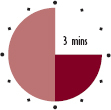Session A
Quality and customers
 1 Introduction
1 Introduction
What is quality?
Is quality the same as excellence, and if so, how do we know when something is excellent? What makes one thing of higher quality than another? Why is quality important: what benefits does it bring? Should you expect to pay more for quality goods and services? What is ISO 9000?
‘Rule number 1: the customer is always right. Rule number 2: if the customer is wrong, see rule number 1.’ – Dennis F. Kehoe, The Fundamentals of Quality Management, Chapman and Hall. |
By the time you have finished reading this session, the answers to these and other related questions should become clearer. We start by establishing definitions, because quality is one of those words that is much used and little understood. |
 2 Defining quality
2 Defining quality
You may well already have your own views about quality: what it is and how to achieve it. Let’s start by seeing how far we agree.
2.1 What quality is
‘Quality’ is something which is talked about a lot at work and more generally. But do we all mean the same thing when we use the term?
Activity 1

Define the word ‘quality’ in your own words. Think about your own job and organization as you answer this. What do you mean when you talk about ‘quality’ at work?
There have been a number of definitions given of quality. If we look to some famous experts in the subject, we find that they define quality in the following ways:
![]() ‘Meeting of customers’ needs’ (W. Edwards Deming);
‘Meeting of customers’ needs’ (W. Edwards Deming);
![]() ‘Fitness for use’ ( J.M. Juran);
‘Fitness for use’ ( J.M. Juran);
![]() ‘Conformance to requirements’ (Philip B. Crosby).
‘Conformance to requirements’ (Philip B. Crosby).
Others textbook definitions include:
![]() ‘meeting, or exceeding, customer requirements’;
‘meeting, or exceeding, customer requirements’;
![]() ‘the degree to which a product or service satisfies customers’ requirements’.
‘the degree to which a product or service satisfies customers’ requirements’.
Perhaps you worded your definition something along these lines, or said that quality means ‘doing things right first time’ or ‘delivering goods or services of the highest standard’. You may even have quoted the words in the workbook introduction, and said that quality is whatever the customer wants it to mean.
As you would expect, there is an ‘official’ definition given in the International Organization for Standardization’s ISO 9000:2000 Quality Management Systems. Fundamentals and Vocabulary.
Quality is the: ‘degree to which a set of characteristics fulfils requirements’.
A requirement is defined as a: ‘need or expectation that is stated, generally implied or obligatory’.
The International Organization for Standardization (ISO) was set up in the 1940s to develop international standards that could be accepted by all its members. Its members come from over 120 national standards bodies including the British Standards Institution (BSI).
We will be discussing the ISO 9000 family of standards in more detail later in this book.
Activity 2

Read the ISO 9000:2000 definition again. An ‘obligatory’ need is most usually one required by law, but whose ‘stated’ or ‘generally implied’ needs do you think are to be fulfilled?
In some situations, such as when patients require medical treatment, customers may not have the specialist knowledge to know what they need, which makes assessing quality difficult. Normally, however, ‘what the customer needs’ does not mean ‘what the organization thinks is good for the customer’; it means ‘what the customer wants or expects’.
So we can say that:
achieving quality means meeting the customers’ wants or expectations.
This implies that organizations have mechanisms that can establish what the customer wants or expects, and whether or not the customer is getting it.
The customer is the focus of all discussions about quality.
(We mustn’t forget that there are customers inside the organization, too. That’s a topic we’ll look at in the next session.)
But what does the customer want or expect? What do you, as a customer, want or expect when you buy something?
2.2 The dimensions of quality
Activity 3

If you go into a shop to buy something, say a new coat, which of the following would you think of as being to do with the quality of the article?
| Relevant to quality? | |
|
|
|
|
|
|
|
|
|
|
|
|
|
|
|
|
|
|
|
|
|
You would have been right to answer ‘yes’ to all of these, because they all have a bearing on your decision whether or not to purchase.
There are many aspects or dimensions of quality. One way to list them is as follows.
![]() Utility or performance: the main characteristics of a product or service. This determines what a product does and how well it does it, or what a service provides, and how well it provides it. For example, the performance of a dry-cleaning service would be measured by how well clothes are cleaned.
Utility or performance: the main characteristics of a product or service. This determines what a product does and how well it does it, or what a service provides, and how well it provides it. For example, the performance of a dry-cleaning service would be measured by how well clothes are cleaned.
![]() Features: the distinctive properties of products or services, which help to distinguish them from similar offerings. Features may be integral to the item, such as an automatic range finder on a camera, or may be secondary, such as being treated with respect and consideration if you are a patient.
Features: the distinctive properties of products or services, which help to distinguish them from similar offerings. Features may be integral to the item, such as an automatic range finder on a camera, or may be secondary, such as being treated with respect and consideration if you are a patient.
![]() Dependability: a term used to describe the following factors.
Dependability: a term used to describe the following factors.
![]() Availability: the degree to which a product or service can be obtained when the user needs it.
Availability: the degree to which a product or service can be obtained when the user needs it.
![]() Reliability: the probability that the product will not fail within a certain period of time, or that a service will be of a consistently high standard.
Reliability: the probability that the product will not fail within a certain period of time, or that a service will be of a consistently high standard.
![]() Maintainability: how easily and quickly a product or service can be put right if it goes wrong, or upgraded if it becomes obsolete.
Maintainability: how easily and quickly a product or service can be put right if it goes wrong, or upgraded if it becomes obsolete.
![]() Maintenance support: it may theoretically be easy to put things right but only if you can find a repair centre that has all the parts needed, or get hold of the right person on the telephone.
Maintenance support: it may theoretically be easy to put things right but only if you can find a repair centre that has all the parts needed, or get hold of the right person on the telephone.
![]() Usability: the safety, convenience and (perhaps) comfort of a product in use.
Usability: the safety, convenience and (perhaps) comfort of a product in use.
![]() Serviceability: the safety, convenience and (perhaps) duration of a service.
Serviceability: the safety, convenience and (perhaps) duration of a service.
![]() Price: what the product or service costs. Customers do not always go for the lowest price, partly because the amount of money they spend affects their own self-image.
Price: what the product or service costs. Customers do not always go for the lowest price, partly because the amount of money they spend affects their own self-image.
![]() Conformance: how well a product or service meets its specifications. If you buy a car that is described as having metallic paint and anti-lock brakes, that’s what you expect to get.
Conformance: how well a product or service meets its specifications. If you buy a car that is described as having metallic paint and anti-lock brakes, that’s what you expect to get.
![]() Aesthetics: what a product looks like, and how it feels, sounds, tastes, and smells. This dimension is probably the hardest to define, as it depends on customers’ perceptions and perhaps on fashions and trends.
Aesthetics: what a product looks like, and how it feels, sounds, tastes, and smells. This dimension is probably the hardest to define, as it depends on customers’ perceptions and perhaps on fashions and trends.
One other dimension of quality is perceived quality: what impression the customer has of the quality of the product or service, which may or may not be based on complete information.
Customers are often unable to find out everything they want to know before making a purchasing decision, and may not be able to form the right questions to ask. As customers, we would all like to know not only what features are available, but (for example) how dependable are the goods or services we buy. Advertisements do not always help, as they usually contain selective information – or none at all! Decisions frequently have to be made based on:
![]() assurances of sales staff;
assurances of sales staff;
![]() the ‘image’ that the maker’s name conjures up;
the ‘image’ that the maker’s name conjures up;
![]() recommendations of friends or product reviewers;
recommendations of friends or product reviewers;
![]() experiences of similar products or services.
experiences of similar products or services.
It is useful to keep in mind the fact that all these dimensions of quality exists, and that quality is not one simple idea.
Now let’s look at a couple of further definitions.
 3 Design quality and process quality
3 Design quality and process quality
 |
In order to satisfy customers’ wants and expectations, a supplier or service provider must do two things. |
1 Determine what those wants and expectations are, and agree a specification for the product or service that will meet or exceed them.
2 Ensure that the product or service conforms with the agreed specification.
The first step is the design quality; the second is process quality.
Design quality can be defined as the degree to which the specification of the product or service satisfies customers’ wants and expectations.
Process quality is the degree to which the product or service, when it is transferred to the customer, conforms to specifications.
For example, a manufacturer of television sets will survey the market, and try to find out what level of performance and which features customers want and expect, for the price they are prepared to pay. This will depend on the current technology, what features competitors are offering, and so on. The manufacturer will then set out a specification and design a television set to achieve this performance and these features. It will then need to ensure that every set it makes conforms to the specification.
A supermarket chain will go through a similar process, even though it may carry a vast range of products, and may not manufacture any of them. It has to determine what customers want, to specify the features and performance of these products, and to ensure that its suppliers consistently meet the specifications.
Sometimes, the delivery is the most important aspect. In the ‘service’ that a theatre provides, for instance, the audience’s reaction will depend on how well the play is performed. However, a high quality performance can only be achieved through the talents of both the production team and the players.
But let’s pause for a moment, because, in listing our two steps of design quality and process quality, we have rather simplified the business of satisfying customers’ wants.
Activity 4

What factors have we ignored by summarizing quality development as: ‘Find out what the customer wants, specify it, and then make sure the item meets the specification’? Jot down two factors.
A few of the aspects that make the whole business of achieving the right quality more complicated, are listed below. You may have mentioned others.
![]() It can be very difficult to discover what the customer wants. As we have already discussed, the customer can’t always be specific about particular wants and expectations.
It can be very difficult to discover what the customer wants. As we have already discussed, the customer can’t always be specific about particular wants and expectations.
![]() Very often, until goods or services are put on offer by the supplier, the customer cannot know how desirable they are.
Very often, until goods or services are put on offer by the supplier, the customer cannot know how desirable they are.
![]() Performance and/or features are frequently driven by technology or fashion, rather than by customers directly.
Performance and/or features are frequently driven by technology or fashion, rather than by customers directly.
![]() The specification process is fraught with difficulties; for example, it may be hard to:
The specification process is fraught with difficulties; for example, it may be hard to:
![]() describe a design in terms that allow it to be manufactured easily;
describe a design in terms that allow it to be manufactured easily;
![]() define a level of service in such a way that staff know exactly what they have to do in order to achieve it.
define a level of service in such a way that staff know exactly what they have to do in order to achieve it.
However, every organization has to overcome the difficulties, and to develop products and services that customers will buy.
But how does an organization design goods or services to an agreed specification, and ensure conformance to that specification? It can only do this through a system of quality management.
 4 Quality systems
4 Quality systems
A quality system has been defined by Dennis F. Kehoe in The Fundamentals of Quality Management as:
‘The organizational structure, responsibilities, procedures, processes and resources for implementing quality management.’
The quality systems of an organization will determine how successful it is in achieving the required product and service quality. In the next session, we discuss total quality management. For the moment, let us focus on quality control and quality assurance, which, until fairly recently at least, have been the terms used for ‘the work that the quality department does’. These are the systems that are set up mainly to ensure conformance to specification.
4.1 Quality control
Quality control (QC) is concerned with the operational techniques and activities that are used to fulfil requirements for quality.
Typically, quality control specialists will be involved in:
![]() inspection and testing of materials, parts, assemblies and final products, to see whether they conform to defined standards and specifications;
inspection and testing of materials, parts, assemblies and final products, to see whether they conform to defined standards and specifications;
![]() using charts and basic statistics to check results and feed back data;
using charts and basic statistics to check results and feed back data;
![]() maintaining and validating test equipment;
maintaining and validating test equipment;
![]() sampling services to see whether they meet desired quality levels.
sampling services to see whether they meet desired quality levels.
4.2 Quality assurance
Quality control is part of quality assurance (QA).
Quality assurance is defined in ISO 9000:2000 as:
‘part of quality management focused on providing confidence that quality requirements will be fulfilled’.
Quality assurance is intended to implement and manage a quality system. It may be involved in:
![]() producing and maintaining a quality manual, which defines the organization’s quality system;
producing and maintaining a quality manual, which defines the organization’s quality system;
![]() ensuring conformance to the quality system;
ensuring conformance to the quality system;
![]() supplier approval;
supplier approval;
![]() analysing statistical quality data;
analysing statistical quality data;
![]() (perhaps) analysing quality costs;
(perhaps) analysing quality costs;
![]() quality planning.
quality planning.
It has long been realized that simply checking the quality of products is not enough. The quality assurance system must take control of all stages of product manufacture, because:
effective quality must be based on prevention, not detection.
However, the idea of QA as a separate function within an organization is also now recognized as being outdated. Quality assurance must exist, but the whole organization must be involved in promoting and improving quality. This philosophy is embodied in a system called total quality management (TQM), which we will discuss in the next session.
So TQM incorporates QA, and QA incorporates QC, as the following diagram suggests.

 5 Why is quality important?
5 Why is quality important?
We have discussed the fact that product or service quality depends on both design quality and process quality. If we focus on an organization that is trying to improve the quality of its products, we can see that there are two parallel developments going on:
![]() product improvements, which are required to meet the changing wants and expectations of the customer, and
product improvements, which are required to meet the changing wants and expectations of the customer, and
![]() process improvements, resulting from the desire to make production of goods or services more efficient and effective.
process improvements, resulting from the desire to make production of goods or services more efficient and effective.
Activity 5
|
For any commercial company, what would you say was the driving force behind both these developments?
There is a simple one-word answer to this question: competition. The following is a longer explanation.
5.1 Competition
The reason for trying to make better products and services available, and for trying to become more efficient and effective at producing them is that:
|
|
|
|
| |
|
| |
On the other hand: | ||
|
|
5.2 Non-profit-making organizations
Perhaps you work for an organization that isn’t expected to make a profit: a public service organization, for example. If you do, you might argue that your ‘company’ won’t fail, because it doesn’t compete with others, and your customers cannot choose to go elsewhere. ‘In any case’, you may say, ‘our income is assured, as it comes from public funds’.
In the short term, a non-profit-making organization may believe it doesn’t need to worry too much about satisfying its customers. But this can never be true in the longer term. Organizations of all kinds come under scrutiny, and quality standards may be imposed as a result of external inspection. Customers can also apply pressure in a number of ways: through their votes in elections, via the media, by complaining to local members of parliament, and so on.
A school or a hospital cannot afford to continue providing a poor service, for it may ultimately be closed down if it does. A county council or a government that doesn’t please its citizens will find itself voted out of office. Inefficient staff are likely to be replaced. In the past few years, whole sectors of public service have found themselves privatized: the telecommunications, gas, electricity and water industries are obvious examples. No organization can escape the demands of its customers for high quality.
And even organizations that don’t have to make a profit do not have unlimited funds. Money must always be spent wisely, and in response to the needs of customers.
5.3 Consumer legislation
Here’s another reason why quality is important.
Consumer protection legislation makes manufacturers and suppliers liable for any personal injury or damage of property suffered by someone using an unsafe or defective product.
Under the Consumer Protection Act 1987, it is not necessary to prove a manufacturer negligent for a claim to be made. Instead, the only issue at stake is whether the product was defective, and whether its state was the cause of the claimant’s injuries. Thus one defective item could result in a lawsuit.
So a further reason why quality is important is that suppliers and manufacturers will want to ensure that every product that is shipped to a customer is safe. The quality system that must be set up to achieve high levels of quality consistently, is precisely that which will ensure the safety of every item. Such a system must:
![]() keep products and services under careful control;
keep products and services under careful control;
![]() pay attention to every detail in product and process development.
pay attention to every detail in product and process development.
5.4 Other beneficiaries
As we have discussed, the organization will benefit from quality improvements, because organizations providing the best quality are likely to achieve the highest sales, and to make the biggest profits. (To repeat: by high quality we do not mean expensive or luxury items; we mean goods that meet the customers’ wants and expectations.)
They are also least likely to be made liable under the consumer protection laws.
But who else benefits from high quality?
Activity 6
|
Apart from the supplying organization, which other groups of people would you expect to benefit from high quality products and services? Jot down two groups of people you think would benefit, and briefly explain your reasons.
You may have responded by listing the following.
![]() The employees of the organization, for at least two reasons. As the organization becomes more successful, so greater benefits and greater job security can be passed on to employees. Also, the morale in a successful, high quality organization is likely to be higher.
The employees of the organization, for at least two reasons. As the organization becomes more successful, so greater benefits and greater job security can be passed on to employees. Also, the morale in a successful, high quality organization is likely to be higher.
![]() The organization’s customers (and users), because they will receive goods and services of the quality they want.
The organization’s customers (and users), because they will receive goods and services of the quality they want.
As we will discuss in the next session, the concept of internal customers embraces the idea that these two groups can turn out to be the same.
Now we turn from benefits to costs.
 6 The cost of quality
6 The cost of quality
Few organizations know how much they spend on quality. According to Crosby:
‘In manufacturing the price is typically 25 per cent or more of revenue; service companies spend 40 per cent or more of operating expenses.’
However, there are two important statements to make with regard to costs.
The first was expressed in the title of Philip Crosby’s original best-seller, Quality is Free. The message was that:
‘Quality is measured by the price of nonconformance.’
In other words:
the cost of achieving competitive levels of quality is lower than the cost of not achieving them.
The second important point to recognize is that the best managed organizations have been able to reduce their costs of quality to as little as 3 per cent of sales, over a period of time. And they have done this while improving the quality of the product.
Let’s look first at how costs can be assessed.
6.1 The cost components
What are the costs of quality?
Activity 7

Think about your own organization, and the broad areas where money is spent on achieving high quality. You might start by imagining that your team or your organization delivered very poor products or services. What costs would be incurred as a result?
Now assume you wanted to set about improving things. How would this result in extra costs?
Would you expect overall costs to be higher when quality was very poor, or when it was very good? (Explain your reasoning.)
You may have said that:
British Standard 6143 describes two approaches to assessing the costs of quality. BS 6143:1 (1992) The Process Cost Model BS 6143:2 (1993) Prevention Appraisal and Failure Model. The approaches can be used together, but the process cost model is the more up-to-date and in line with ISO 9000. However, the other model (prevention, appraisal and failure) is worth looking at because it raises some useful issues. |
If we analyse quality costs, we find they can be separated into four components:
|
They are grouped as shown in the next figure.
Defective goods and services must be eliminated before they reach the customer, and this can be done either through prevention or appraisal.
There are the control costs. |
Prevention costs include:
|
Appraisal costs include:
|
Failures may occur either internally (during the production process), or externally (after the product or service has been delivered).
These are the failure costs. |
Internal failure costs include the costs of:
|
External failure costs include the costs of:
|
When organizations do consider the cost of quality, they may be misled into believing that there is a trade-off to be made between costs and quality.
6.2 Quality costs – the traditional view
According to the traditional view of quality costs, there is a ‘law of diminishing returns’. Look at the graph below, which is intended to support this view.

The theory is as follows.
The costs of failure rise in direct proportion to the quantity of defects, so you have to control quality, and this will mean investing time and money. Generally speaking, the higher the quality (that is, the smaller the number of defects – see the left hand side of the graph), the bigger the investment in quality control. Your total costs are made up of failure (i.e. defect) costs and (quality) control costs. You need to find the point at which this combination of failure costs and control costs is lowest. To achieve fewer faults than this, you will need to spend a disproportionate amount: see how sharply the graph rises to the left – this is the meaning of ‘diminishing returns’.
Activity 8
|
It sounds convincing enough, but what are the implications? Can you see any flaws in this traditional argument?
Perhaps you agree with this view, which says we should not aim to reach the fewest number of failures, but should invest just enough in controlling quality to minimize the total costs. This implies that, for the supplier, there is an ‘acceptable’ failure rate and that:
![]() the manufacturer will be satisfied to always allow a certain number of defects to slip through;
the manufacturer will be satisfied to always allow a certain number of defects to slip through;
![]() the service provider will plan to allow a certain amount of inefficiency.
the service provider will plan to allow a certain amount of inefficiency.
But what about the customer?
Are you, as a customer, happy to accept that a few things will be wrong when, say, you take delivery of a new radio or washing machine? Or, if you go to hospital for an operation, and are told: ‘We try not to make mistakes, but we can’t afford to be so efficient that we don’t lose a few patients’, will you smile philosophically? If you’re anything like the average customer, you’d be rather upset at such an attitude. In fact, if you have any choice, you’ll go elsewhere for your goods and services.
So this traditional argument no longer stands up to reality: customers are increasingly reluctant to put up with shoddy goods or services. If you make compromises on quality, at the very least you can expect a lot of complaints. And if you ignore what your customers are telling you, you won’t survive.
Many organizations nowadays no longer think along traditional lines, as the following story illustrates.
A European company ordered some components from a Japanese firm. The order stated: ‘10,000 items required, with a defect rate of 0.03%’. What they meant was that there should be no more than three defective items in the batch of 10,000. When the parts arrived, there were two boxes, one containing 9,997 good components, and another containing three defective ones, clearly labelled as such. The supplier could not understand why the customer wanted defective components, but it was happy to oblige.
Manufacturers are used to talking about ‘acceptable quality levels (AQL)’, a term that applies to statistical sampling. To explain: if you take a small sample from a large batch, the number of defective items in the sample will give you an idea of the total number there are likely to be in the batch. The AQL is the maximum percentage of defectives in a sample, that can be considered acceptable as a process average. Unfortunately, the term ‘acceptable quality level’ is frequently interpreted to mean that it’s OK to make defective goods.
Philip Crosby, in his subsequent book Quality is Still Free (McGraw-Hill, 1996), gives an insight into this attitude.
‘When I started in the quality world in 1952 my first lesson was about AQLs. There was scientific proof that it cost a lot less to plan on things not being correct. “It would take a fortune to do everything right every time” was contained in every explanation. So all processes were planned around these statistics. It was a great performance standard because we weren’t expected to do it right and when we didn’t there was no problem. Suppliers had AQLs included in the purchase order so they could have a defect rate of 1 per cent, 2 per cent, and such. Sloppy executives love AQLs.
It was the frustration created by this belief that led me to create the Zero Defects concept in 1961. Suppliers would come to me, as quality manager of the weapons system project, for their “AQL”. … Software development for instance, wanted to know how many errors they could have per line of programming. … My response was that they had bid the contract to supply this service or product and I expected it to appear exactly as promised. There would be no AQL.’
6.3 Quality costs – the process cost model
The prevention, appraisal and failure approach is not as useful as the process cost model for two reasons.
![]() Partly because it is difficult to apply in practice, especially in a modern business. Many costs fit into all four categories.
Partly because it is difficult to apply in practice, especially in a modern business. Many costs fit into all four categories.
![]() Mainly because of the assumption that quality is achieved through quality control measures and inspection. Although the prevention, appraisal and failure approach recognizes that increasing the amount spent on prevention should mean that total costs reduce, it does not recognize that in the longer term, prevention costs themselves should be a target for reduction.
Mainly because of the assumption that quality is achieved through quality control measures and inspection. Although the prevention, appraisal and failure approach recognizes that increasing the amount spent on prevention should mean that total costs reduce, it does not recognize that in the longer term, prevention costs themselves should be a target for reduction.
The more modern ‘process’ approach (as set out in British Standard 6143 Part 1) does not have separate categories for quality costs. The only division of costs that is valid is between the costs of conformance and the costs of non-conformance.
Here are the definitions given in BS 6143:1.
![]() Process
Process
A process is ‘any activity that transforms inputs into outputs utilising resources and being subject to particular controls’. In effect absolutely everything that a business does can be described as a process.
![]() Cost of conformance
Cost of conformance
This is ‘the intrinsic cost of providing products or services to declared standards by a given, specified process in a fully effective manner’.
![]() Cost of non-conformance
Cost of non-conformance
This is ‘the cost of wasted time, materials and capacity (resources) associated with a process in the receipt, production, despatch and correction of unsatisfactory goods and services’.
Activity 9
|
BS 6143:1 says that costs of any process can be further analysed under four sub-categories: people, equipment, materials and environment. Try to think of an example of a cost of non-conformance due to the working environment.
There are many possible answers. One suggestion is the cost of the time wasted because a document goes missing: this is quite often due to bad office layout and inadequate filing facilities. (If you address this problem by putting up more shelves and buying more folders those would be costs of conformance, because the expenditure makes your process(es) more effective.)
See if you can think of further examples under each category in Activity 9.
The basis of the process cost model is to realize that both areas of cost (conformance and non-conformance) offer opportunities for improvement: that is, they can be reduced.
Some processes exist only because of non-conformance in another process. For example, suppose that the job of Department B is to paint the output of Department A green. Department B is very effective at painting things green, and the output of Department A conforms precisely to the standards set. So is there scope for improvement?
There is, of course, because non-conformance occurs in the department that purchases non-green materials for Department A! If that were attended to there would be no need for Department B at all.
The point is more obvious if it is the job of Department B to correct errors in the work of Department A. As you’ve guessed, if Department A could improve its processes to the extent that it did not make errors in the first place there would be no need for Department B. Improvements might come from one-off expenditure on things such as better training and better equipment, etc. so that non-conformance expenditure is no longer necessary.
This takes us into the area of Total Quality Management: get it right first time! We’ll discuss TQM in much more detail in Session B.
 7 Dependability
7 Dependability
As mentioned earlier, an important aspect of quality is dependability.
Activity 10

Jot down in your own words what you understand when you hear a product or a service described as being dependable.
If a friend is dependable you know you can rely on them to be there when they promised to be there, or to do things that they promised to do.
When it comes to a product or a service, a good simple definition would be that it is dependable if it functions properly whenever you need it.
For example, a dependable car starts every time, and does not break down when you want to go from A to B. If your dependable car is stolen, a dependable insurance company makes it easy to claim and pays out promptly.
7.1 The bath-tub curve
Most manufactured products have something in common with living creatures – they have a limited life-span.
The life-span of a product, like that of a living creature, can be separated into three time periods: infancy, working life, and ‘old age’.
When we talk about the dependability of products, we generally refer to these time periods or regions in the following way.
![]() Burn-in: this name reflects the fact that many products are run in or ‘burned in’ immediately after they are produced.
Burn-in: this name reflects the fact that many products are run in or ‘burned in’ immediately after they are produced.
![]() Useful life: the time when the product is in active use.
Useful life: the time when the product is in active use.
![]() Wear-out: the period when useful life has come to an end.
Wear-out: the period when useful life has come to an end.
Look at the diagram below. It is a graph of the probability of failure rates for a number of products over their whole life-span.

This is the typical bath-tub curve describing the life of most products and services (the graph gets its name from its shape). You can see that the probability of failure drops during the burn-in period, and then is very low for a long time during the useful life region. Towards the end of its life, the probability of failure of the product rises once more. This is what you might expect.
![]() In ‘infancy’ there is more likelihood that the product will fail. There may have been faulty components or materials installed, or the product may have been incorrectly manufactured.
In ‘infancy’ there is more likelihood that the product will fail. There may have been faulty components or materials installed, or the product may have been incorrectly manufactured.
![]() As time goes by, all the faulty components and materials ‘settle down’ (or have been replaced). During the useful life of the product fewer failures can be expected.
As time goes by, all the faulty components and materials ‘settle down’ (or have been replaced). During the useful life of the product fewer failures can be expected.
![]() Later, components and materials start to wear out, and the rate of failure increases again.
Later, components and materials start to wear out, and the rate of failure increases again.
Activity 11
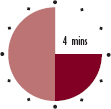
Do you think that services also tend to follow this ‘bath-tub’ curve? Do services ‘burn-in’ or ‘wear out’? Briefly jot down your ideas on this subject. If you work in a service industry, try to imagine what kind of reliability curve would be applicable, if any.
Let’s think of an example. Suppose a local authority decides to set up a service to collect paper or other materials for recycling. It would perhaps need to let householders and firms know about the service, to distribute special containers, train staff, and so on. There would be many things to organize, and lots that might go wrong to start with: the authority could be overwhelmed (or ‘under-whelmed’) by the response, say, or it might find that people were still mixing up their rubbish with the paper. So we can say that there would be a period of settling down – equivalent to the ‘burning in’ of products.
After the initial period, when things are going smoothly, we would expect the problem rate to be low.
Like a product, which can fail at any time, a service can cease suddenly, by being withdrawn. In the case of the paper collection, a new council might decide it could no longer afford to provide this service. Services don’t wear out, but they may change. For instance, the patients of a surgery might be unhappy if a doctor leaves and a new one arrives; they may experience a new settling-in period, as patients and doctor get to know one another.
Other kinds of products tend not to have a long flat part of the curve at all. A complex mechanical system will tend to wear out more quickly and more frequently than, say, an electrical one. The bath-tub curve for mechanical systems typically looks like the one shown below.
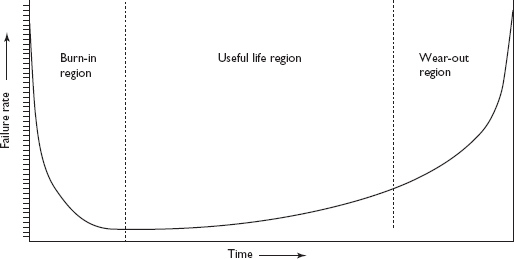
7.2 Reducing failure rates
Obviously, if you buy a product – a car, say – dependability is very important to you. But dependability is also important for the manufacturer of the product. Most manufacturers (and others who pass on the product, such as distributors) are likely to be very concerned about dependability. Similarly, service providers know that they will only continue to keep their customers by offering a dependable service.
As we’ve said, dependability is an aspect of quality. If products or services are not dependable, they don’t provide the quality that customers demand. This will result in customers buying different products or services, or buying from competitors.
Activity 12 |
 |
How can a product or a service be made more dependable? Imagine you are responsible for the manufacture of an item of kitchen equipment, say, or for providing a school catering service. Knowing what you do about the way products and services fail, and thinking about the shape of the bath-tub curve, write down one action you might take to improve reliability.
There are a number of ways of trying to achieve high dependability.
| EXTENSION 1 If you would like to learn more about the important subject of reliability, the book Total Quality Management, by John S. Oakland has further information on reliability management. |
|
Any organization concerned about dependability will study:
![]() how and why failures can occur, and
how and why failures can occur, and
![]() what the consequences of each failure might be,
what the consequences of each failure might be,
before it considers a product or service ready for the market.
Dependability problems may also arise because of changes that are beyond the organization’s control. For instance, a map may become out of date because new roads are built. A computer program may become out of date because of changes to the computers or operating systems that it runs on. In such cases the dependable organization will address the issues of maintainability and maintenance support. The computer industry provides good examples.
![]() Maintainability: a dependable software company will release upgrades of its products, if upgrades are necessary, to ensure that the product works properly on a new operating system (a new version of Windows, say). These upgrades will be ‘backwards-compatible’: in other words they will still be able to work with data created using the old version of the software.
Maintainability: a dependable software company will release upgrades of its products, if upgrades are necessary, to ensure that the product works properly on a new operating system (a new version of Windows, say). These upgrades will be ‘backwards-compatible’: in other words they will still be able to work with data created using the old version of the software.
![]() Maintenance support: a dependable hardware company will make new drivers available, and freely downloadable, from its website if the printers that it sells need them to work properly with a new operating system.
Maintenance support: a dependable hardware company will make new drivers available, and freely downloadable, from its website if the printers that it sells need them to work properly with a new operating system.
What are the likely consequences of a failure? The most serious possible consequence, as we discussed earlier, is that someone is hurt. Health and safety is therefore a primary concern. Another is that one component in a product breaking down or being mishandled might cause other components to fail. It is for these reasons that designers aim to make their products ‘fail safe’. For example, if a switch on a powered lawn-mower breaks, it should result in the power being kept off, not left on. Similarly, a user shouldn’t be able to cause damage to a radio, say, by inserting the batteries the wrong way round.
A failure of a service might also result in a health or safety problem, and you could no doubt think of many obvious examples in medicine. Also, like products, services usually involve many groups or ‘service components’ acting independently, yet relying on one another. To get fresh fruit or vegetables half way round the world, and always in your local shop when you want to buy them, requires a great deal of co-ordination and organization, for example.
So we can say that the dependability of goods and services is a complex subject. High levels of dependability, like other aspects of quality, can only be achieved through careful planning.
That concludes our brief treatment of dependability. We switch subjects now, and look at quality standards and accreditation.
 8 Certification and accreditation schemes
8 Certification and accreditation schemes
For some time now, there has been growing pressure on manufacturers and service providers to comply with defined national and international standards, both for their products and for their quality systems. Let’s start by looking at some important organizations.
8.1 The standards bodies
The main standards-setting body in the UK is the British Standards Institution (BSI). In fact, it was the first national standards body in the
world. There are now more than 120 similar organizations in other countries. BSI publishes many thousands of standards and other publications, covering items as diverse as dentistry, computer languages and library buildings.
There are several international bodies which attempt to ensure that national standards are equivalent to one another. The most important of these is the International Organization for Standardization (ISO).
One of the aims of the European Union (EU) has been agreement on product quality standards. The intention is that goods which conform to the national standards of one member state will be accepted in all the other states.
At the end of 1992, the ‘single market’ was formed within the EU. Since this date the following points apply.
![]() Only ‘essential requirements’ which relate to health, safety, consumer protection and the environment are the subject of agreement as EU standards. These are issued as ‘Directives’, and have the backing of the law.
Only ‘essential requirements’ which relate to health, safety, consumer protection and the environment are the subject of agreement as EU standards. These are issued as ‘Directives’, and have the backing of the law.
![]() Except for these essential requirements, all member states have to recognize and accept test results and certificates issued by other EU national standards bodies.
Except for these essential requirements, all member states have to recognize and accept test results and certificates issued by other EU national standards bodies.
8.2 Quality systems standards
However, we must distinguish between standards that define the required quality of products and services, and those standards that relate to quality systems. Quality systems standards set out the minimum requirements for an organization’s quality assurance system. They are typically used:
![]() to provide guidance to supplier organizations that are introducing quality assurance systems;
to provide guidance to supplier organizations that are introducing quality assurance systems;
![]() as a framework for evaluating the quality systems of suppliers;
as a framework for evaluating the quality systems of suppliers;
![]() to form the basis of a contract for quality system requirements.
to form the basis of a contract for quality system requirements.
Quality system standards should not be confused with product or service standards. They do not specify what a specific item is or does; instead they are intended to ensure that agreed levels of quality are met for any product or service.
Some system standards apply to particular industries. For instance, the production, processing, distribution, retail, packaging and labelling of foodstuffs are governed by a mass of laws, regulations, codes of practice and guidance. This is all overseen in the UK by the Food Standards Agency.
Some large organizations have developed their own standards. For instance, Ford Motor Company has launched a back-to-basics quality process, called Q1 2002, that requires continual improvement from its suppliers.
The most widely adopted general quality system standard is ISO 9000.
8.3 ISO 9000
| EXTENSION 6 There is a list of quality system elements in ISO 9000:2000 on page 90. |
The term ISO 9000 refers to a family of quality management standards. The latest versions were published at the end of 2000. |
The ISO 9000 family includes four principal standards.
In the UK, ISO 9000 is more properly referred to as BS EN ISO 9000. The BS indicates that it is endorsed by the British Standards Institution (BSI) and the EN indicating that it is endorsed by the committee for standardization (CEN). Quality management standards began in the UK with BS 5750 in 1978. This was re-issued in 1994, in slightly modified form as BS EN ISO 9000, which had three parts: ISO 9001, ISO 9002 and 9003. The 1994 version has been entirely superseded by the 2000 version. The numbers 9002 and 9003 are no longer used. |
If an organization wishes to obtain certification of its quality system it will be audited and assessed according to the requirements set out here.
There are also a number of subsidiary standards on more specialist topics such as requirements for measuring equipment, requirements specific to automotive suppliers, and so on. |
8.4 Certification under ISO 9001
Certification is primarily a safeguard for organizations that you do business with. As an analogy, think about driving a car.
Activity 13
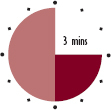
Suppose you can drive a car very well but you have not yet taken your driving tests and got a full driving licence. What things might you be prevented from doing until you get your licence?
Here are some suggestions. You may have thought of other things.
![]() You won’t be able to get full insurance (a legal requirement) for your car.
You won’t be able to get full insurance (a legal requirement) for your car.
![]() You won’t be able to hire a car from a car hire company.
You won’t be able to hire a car from a car hire company.
![]() You won’t be able to get a job that involves driving.
You won’t be able to get a job that involves driving.
In the same way, your organization may be prevented from undertaking certain activities unless it can provide independent verification that its work is likely to be of the required quality.
You will come across this most often in government contracts. Central and local governments employ many private sector organizations and pay them large amounts of public money to provide services such as cleaning, building works, road repairs and so on.
One way of ensuring that the work is done to the required standard is to insist on seeing some independent ‘licence’: in this case, an ISO 9001:2000 certificate.
If an organization were certified under the 1994 version of ISO 9001 and wanted to retain ISO 9001 certification, it would have until 15 December 2003 to convert its systems to comply with the new standard. |
To become certified the organization has to develop a quality management system that meets the requirements specified by ISO 9001:2000. (Note that ISO 9000 and ISO 9004 are guidelines, not requirements.) Once the quality system has been fully developed and implemented, the organization must ask an independent registrar to audit it. Registrars are organizations who are accredited to issue ISO 9001 certificates by the United Kingdom Accreditation Service (UKAS). All being well, the registrar will issue an official certificate. Potential customers will accept this as proof of compliance with ISO 9001. |
Activity 14
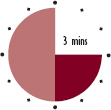
What do you think would be the benefits to an organization of accreditation to ISO 9001? Try to list two benefits. (If your own organization already has accreditation, you may find this question fairly easy.)
There are several possible benefits, not the least of which is an increase in business. The following diagram gives an indication of how much companies have benefited from accreditation.
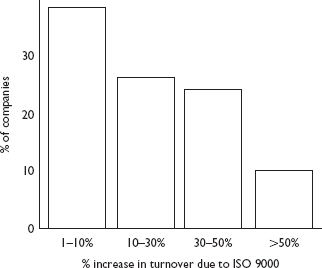
Other benefits are as follows.
![]() The standard is so widely recognized that there is usually no need for an organization’s quality system to undergo investigation by any customer, to any other standard, once accreditation to ISO 9001 has been achieved.
The standard is so widely recognized that there is usually no need for an organization’s quality system to undergo investigation by any customer, to any other standard, once accreditation to ISO 9001 has been achieved.
![]() Buying from accredited suppliers gives the customer an assurance that the required level of quality of product or service will be reached – this is particularly important in view of the implications of consumer protection law.
Buying from accredited suppliers gives the customer an assurance that the required level of quality of product or service will be reached – this is particularly important in view of the implications of consumer protection law.
![]() ISO 9001 provides a foundation upon which to build future quality improvements.
ISO 9001 provides a foundation upon which to build future quality improvements.
![]() Many larger customers demand ISO 9001 accreditation of suppliers before they will award contracts.
Many larger customers demand ISO 9001 accreditation of suppliers before they will award contracts.
8.5 But does ISO 9001 certification really indicate quality?
The 1994 version of ISO 9000 received a good deal of criticism, and until the 2000 version is better known you may still encounter opposition of the following kind.
![]() ISO 9000 suggests appointing a ‘quality representative’ who will be a large influence within the organization to encourage change, but it is well-known that top management are the most effective in leading organizational change.
ISO 9000 suggests appointing a ‘quality representative’ who will be a large influence within the organization to encourage change, but it is well-known that top management are the most effective in leading organizational change.
![]() ISO 9000 is limited in its vision, focusing only on the product or service of the company.
ISO 9000 is limited in its vision, focusing only on the product or service of the company.
![]() ISO 9000 is conservative because it only aims to ensure that the product or service conforms to specified requirements, and does not aim to achieve ‘customer delight’.
ISO 9000 is conservative because it only aims to ensure that the product or service conforms to specified requirements, and does not aim to achieve ‘customer delight’.
![]() Once ISO 9000 requirements are laid down, it is unlikely that demanding targets for any further improvement will be set.
Once ISO 9000 requirements are laid down, it is unlikely that demanding targets for any further improvement will be set.
These criticisms were valid for the 1994 version of the standard particularly because of the rigid way in which many registrars interpreted it. Some companies that clearly had excellent quality systems did not achieve certification because they did not get enough ticks on audit checklists! Some companies that merely paid lip-service to the standard, with no real commitment to quality, found it easy to get certified.
Hopefully many of the problems have been addressed in ISO 9000:2000.
![]() The revised standard makes it clear that the main responsibility for the quality management system lies with top management.
The revised standard makes it clear that the main responsibility for the quality management system lies with top management.
![]() In the revised standard, quality planning activities include objectives at each relevant function and level within the organization.
In the revised standard, quality planning activities include objectives at each relevant function and level within the organization.
![]() Under ISO 9000:2000, organizations are expected not merely to meet customer expectations but to ‘exceed’ them if possible.
Under ISO 9000:2000, organizations are expected not merely to meet customer expectations but to ‘exceed’ them if possible.
![]() Throughout ISO 9000:2000 emphasis is placed on the importance of continual improvement.
Throughout ISO 9000:2000 emphasis is placed on the importance of continual improvement.
In general the new standard has fewer rigid rules than the old standard. Specific ‘procedures’ are much less often required: this gives organizations much more flexibility in deciding how they are going to meet the requirements, and auditors more scope to interpret the requirements and judge compliance in a way that is appropriate to each organization’s particular circumstances.
8.6 Investors in People recognition
The Investors in People Standard was developed in 1990 and had input from a number of organizations including the Confederation of British Industry (CBI), the Trades Union Congress (TUC) and the then Institute of Personnel Management (IPM).
It is often seen as being complementary to ISO 9000. It focuses on the management of people, and the contribution that this management makes both to the overall business mission and strategy, and to delivering high quality. Recruitment, development of staff and communications are among those aspects covered. The process uses four key principles: commitment, planning, action and evaluating, to feed into a cyclical process that should lead to continuous improvement. Because Investors in People highlights the people in the organization, it is regarded as a way of humanizing the concentration on systems in ISO 9000.
Activity 15

How do you think that concentrating on recruitment, staff development and communications will contribute to the quality of the organization’s product?
You may have mentioned some of the following.
![]() Staff development should produce a better motivated staff, which is more likely to produce good quality work.
Staff development should produce a better motivated staff, which is more likely to produce good quality work.
![]() Absenteeism is reduced where staff are better motivated, leading to continuity and reliability of the service or product.
Absenteeism is reduced where staff are better motivated, leading to continuity and reliability of the service or product.
![]() Good communications mean that important information is shared more easily and quickly, so that changes can be quickly implemented.
Good communications mean that important information is shared more easily and quickly, so that changes can be quickly implemented.
![]() Investors in People recognition is attractive to employees and may attract reliable and talented employees to work for the organization.
Investors in People recognition is attractive to employees and may attract reliable and talented employees to work for the organization.
Self-assessment 1
|
1 Give a valid definition of quality.
2 Match each of the following terms on the left with the correct description on the right.
| Quality assurance | What a product looks like, and how it (QA) feels, sounds, tastes, and smells. |
| Process quality | The degree to which the specification of the product or service satisfies customers’ wants and expectations. |
| Dependability | The degree to which the product or service, when it is transferred to the customer, conforms to specifications. |
| Design quality | All those planned and systematic actions necessary to provide adequate confidence that a product or service will satisfy given requirements for quality. |
| Aesthetics | This is concerned with the operational techniques and activities that are used to fulfil requirements for quality. |
| Quality control (QC) | The probability that a product will not fail within a certain period of time, or that a service will be of a consistently high standard. |
3 Identify the three regions in the diagram below.
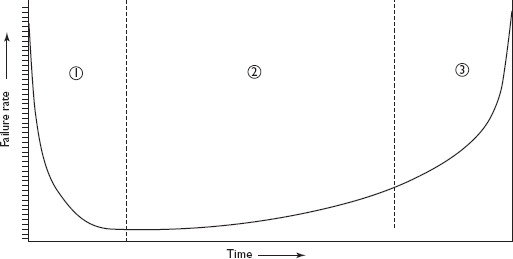
4 Fill in the correct terms in the table below:

5 Fill in the blanks in the following sentences with suitable words, chosen from the list below.
a The main driving force behind quality is _______________.
b The ______________ is the focus of all discussions about quality.
c ________________ quality can be defined as the degree to which the ____________ of the product or service satisfies customers’ wants and expectations.
d ____________ quality is the ____________ to which the product or service, when it is transferred to the customer, conforms to specifications.
e A quality ____________ can be defined as the organizational ____________, responsibilities, ____________, processes and resources for implementing quality management.
f Quality is measured by the price of ____________.
g Availability is the ____________ to which a product or service can be ____________ when needed.
ABILITYCOMPETITION CUSTOMERDEGREE
DESIGNOBTAINEDFUNCTIONNONCONFORMANCE
PROCEDURES PROCESSSPECIFICATION STRUCTURE
SYSTEM
Answers to these questions can be found on pages 92–3.
9 Summary
![]() ISO 9000:2000 defines quality as ‘The degree to which a set of characteristics fulfils requirements’.
ISO 9000:2000 defines quality as ‘The degree to which a set of characteristics fulfils requirements’.
![]() Put more simply, we can say that achieving quality means meeting the customers’ wants or expectations, because of the following points.
Put more simply, we can say that achieving quality means meeting the customers’ wants or expectations, because of the following points.
![]() The customer is the focus of all discussions about quality.
The customer is the focus of all discussions about quality.
![]() The dimensions of quality include: utility or performance; features; dependability; usability; serviceability; price; conformance; aesthetics.
The dimensions of quality include: utility or performance; features; dependability; usability; serviceability; price; conformance; aesthetics.
![]() A further dimension of quality is perceived quality: what impression the customer has of the quality of the product or service.
A further dimension of quality is perceived quality: what impression the customer has of the quality of the product or service.
![]() Design quality and process quality are both integral parts of quality development. Design quality can be defined as the degree to which the specification of the product or service satisfies customers’ wants and expectations. Process quality is the degree to which the product or service, when it is transferred to the customer, conforms to specifications.
Design quality and process quality are both integral parts of quality development. Design quality can be defined as the degree to which the specification of the product or service satisfies customers’ wants and expectations. Process quality is the degree to which the product or service, when it is transferred to the customer, conforms to specifications.
![]() Quality control (QC) is concerned with the operational techniques and activities that are used to fulfil requirements for quality.
Quality control (QC) is concerned with the operational techniques and activities that are used to fulfil requirements for quality.
![]() Quality assurance (QA) is defined in ISO 9000:2000 as ‘Part of quality management focused on providing confidence that quality requirements will be fulfilled’.
Quality assurance (QA) is defined in ISO 9000:2000 as ‘Part of quality management focused on providing confidence that quality requirements will be fulfilled’.
![]() QA incorporates QC, and TQM (Total Quality Management) incorporates QA. It is a serious mistake to think that quality assurance is the business of one group or department.
QA incorporates QC, and TQM (Total Quality Management) incorporates QA. It is a serious mistake to think that quality assurance is the business of one group or department.
![]() The main driving force behind quality is competition. Non-competitive organizations usually have other pressures acting upon them to drive up quality.
The main driving force behind quality is competition. Non-competitive organizations usually have other pressures acting upon them to drive up quality.
![]() Organizations, customers and employees all benefit from quality.
Organizations, customers and employees all benefit from quality.
![]() In the PAF (prevention, appraisal and failure) model of quality costing, prevention costs and appraisal costs comprise control costs; internal and external failure costs, together with control costs comprise total quality costs.
In the PAF (prevention, appraisal and failure) model of quality costing, prevention costs and appraisal costs comprise control costs; internal and external failure costs, together with control costs comprise total quality costs.
![]() In theory, high levels of quality ‘cost a fortune’, but this assumes quality is achieved through quality control measures and inspection. Also, it does not take into account the costs of non-conformance and the savings that can be made across all areas of the business by improvements.
In theory, high levels of quality ‘cost a fortune’, but this assumes quality is achieved through quality control measures and inspection. Also, it does not take into account the costs of non-conformance and the savings that can be made across all areas of the business by improvements.
![]() A dependable product or service is one that functions properly whenever you need it.
A dependable product or service is one that functions properly whenever you need it.
![]() The ‘bath-tub’ curve reflects the fact that product failures are typically high during ‘infancy’ and ‘old age’. Modified forms of the curve apply to products and services of all kinds.
The ‘bath-tub’ curve reflects the fact that product failures are typically high during ‘infancy’ and ‘old age’. Modified forms of the curve apply to products and services of all kinds.
![]() The British Standards Institution was the first standards body in the world. The most important international body is the International Organization for Standardization (ISO).
The British Standards Institution was the first standards body in the world. The most important international body is the International Organization for Standardization (ISO).
![]() The most widely adopted general quality system standard is ISO 9000. There are four principal standards.
The most widely adopted general quality system standard is ISO 9000. There are four principal standards.
![]() ISO 9000:2000 Quality management systems. Fundamentals and vocabulary describes the basic concepts and terminology for quality management systems.
ISO 9000:2000 Quality management systems. Fundamentals and vocabulary describes the basic concepts and terminology for quality management systems.
![]() ISO 9001:2000 Quality management systems. Requirements specifies requirements for quality management systems for organizations wishing to demonstrate ability to provide products that fulfil customer and regulatory requirements.
ISO 9001:2000 Quality management systems. Requirements specifies requirements for quality management systems for organizations wishing to demonstrate ability to provide products that fulfil customer and regulatory requirements.
![]() ISO 9004:2000 Quality management systems. Guidelines for performance improvements is a detailed version of ISO 9001:2000 used for guidance purposes.
ISO 9004:2000 Quality management systems. Guidelines for performance improvements is a detailed version of ISO 9001:2000 used for guidance purposes.
![]() ISO 19011:2002 Guidelines on Quality and/or Environmental Management Systems Auditing includes guidance on auditing quality and environmental management systems.
ISO 19011:2002 Guidelines on Quality and/or Environmental Management Systems Auditing includes guidance on auditing quality and environmental management systems.
![]() Benefits of accreditation to ISO 9001 include:
Benefits of accreditation to ISO 9001 include:
![]() the likelihood of increased business;
the likelihood of increased business;
![]() use as a foundation on which to build future quality programmes.
use as a foundation on which to build future quality programmes.
![]() The earlier version of ISO 9000 had its critics. Perhaps the greatest danger is in assuming that, once this big step has been taken, there’s nothing more to be done. The new ISO 9000 family attempts to be more flexible, places more responsibility with senior management and concentrates on continuous improvement and exceeding expectations.
The earlier version of ISO 9000 had its critics. Perhaps the greatest danger is in assuming that, once this big step has been taken, there’s nothing more to be done. The new ISO 9000 family attempts to be more flexible, places more responsibility with senior management and concentrates on continuous improvement and exceeding expectations.
![]() Investors in People recognition is often seen as being complementary to ISO 9000. It focuses on the management of people, and the contribution that this management makes to the overall business mission and strategy, and to delivering high quality.
Investors in People recognition is often seen as being complementary to ISO 9000. It focuses on the management of people, and the contribution that this management makes to the overall business mission and strategy, and to delivering high quality.




